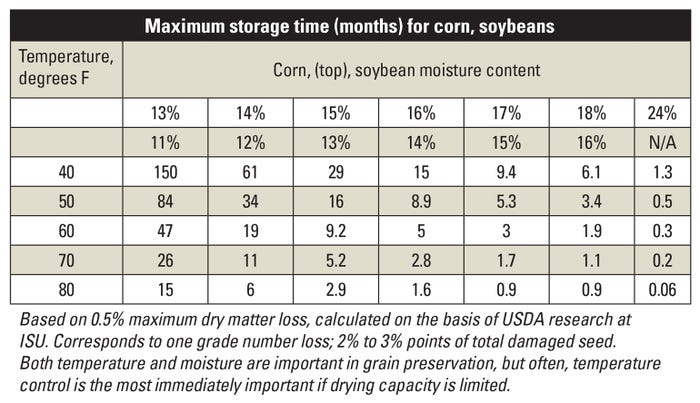January 10, 2020

Many producers put grain into their storage bins last fall at higher moisture contents than normal, due to late crop maturity and less in-field drying in 2019. For grain stored wetter than recommended through the winter (above 15% for corn and 13% for soybeans), be sure to monitor grain to ensure no loss in condition.
According to Kristina TeBockhorst and Shawn Shouse, Iowa State University Extension ag engineering specialists, maintaining grain temperatures below 35 to 40 degrees F is the best defense against spoilage for grain that is wetter than ideal. To do so, aerate grain to cool it after filling the bin in the fall, plus aerate as often as needed throughout the winter to keep grain cool.
Even after cooling, grain can warm up in storage bins in the winter by solar heating — the sun shining on the bin roof and south-facing walls.
The time required to fully aerate a bin depends on fan size or airflow. A small aeration fan (typically moving 0.1 cubic feet per minute per bushel) can take nearly a week to fully cool a bin of corn. To determine how long to run your aeration fan, read the ISU Extension article Cool stored grain now. You should err on the side of running the fan too long to prevent uneven grain temperatures. Run the aeration cycles when the outside air temperature averages 30 to 35 degrees.
Monitor grain weekly
This winter, as you are monitoring grain condition weekly and aerating as needed, be sure to inspect and probe the grain for crusting, damp spots and warm spots. Smell the first flush of exhaust air after turning on the fan to notice any off-smelling odors that indicate molding (musty or sour).
The first flush of air exits the grain within seconds for a large drying fan and within minutes for an aeration fan. Have a plan of action and be ready to move grain at the first sign of it going out of condition. Remember, grain above safe storage moisture content will have to be dried or marketed before warm temperatures return in spring.
Producers should also be aware that low test-weight corn or low-quality grain will have a shorter allowable storage time than good-quality grain. Corn with a test weight below 53 pounds per bushel may only have about half the effective storage life of 56 pounds per bushel corn. It is not advised to store grain longer than half of its allowable storage time to reduce the risk of quality loss before marketing.

Source: ISU, which is solely responsible for the information provided and is wholly owned by the source. Informa Business Media and all its subsidiaries are not responsible for any of the content contained in this information asset.
You May Also Like




